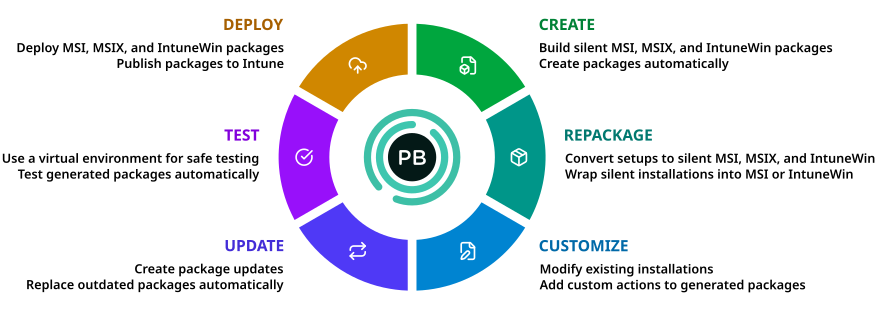Getting Started
EMCO MSI Package Builder is a packaging tool that allows you to repackage non-silent installations into silent MSI, MSIX and IntuneWin packages and create custom silent installations quickly and easily. The program uses a unique repackaging technology that allows converting almost any non-silent installation into a silent package to enable its automatic deployment using Intune, SCCM, Group Policy or other software distribution tools. The same technology can be used for automatic creation of customized installation packages.
|
Using EMCO MSI Package Builder, you can benefit from the following features that are demonstrated in the course of this tutorial.
- Multiple installation packaging methods. Depending on the project, you can use one of the provided packaging methods that are suitable for that project. You can convert non-silent installations into a silent MSI or MSIX automatically using Live Monitoring. In the specific cases, when Live Monitoring cannot be used, you can wrap installations into an MSI or IntuneWin package if those installations can be deployed silently.
- Best-in-class repackaging technology. The program allows you to repackage a non-silent installation of any complexity into a silent MSI or MSIX package. The program supports repackaging of installations that perform complex changes such as modifying file system and registry permissions, installing Windows services and drivers, changing Windows environment variables, etc.
- Automatic MSI/MSIX creation. The program allows you to repackage EXE to MSI/MSIX automatically: you just need to go through the deployment steps of the original EXE installation, and the program will capture all the performed changes on the fly and generate an MSI/MSIX for you. You can also use the Live Monitoring technology to monitor any activity on a PC and generate an MSI/MSIX package reproducing the captured changes.
- Easy MSI/MSIX customization. Having created an MSI/MSIX package, you can edit it, if required. You can have an access to all captured changes to modify them or add additional changes. You can also configure the MSI package to execute any scripts or executable files before and after the MSI installation.
- Repackaging on virtual machines. You can repackage installations not only on a local machine but also on virtual machines by connecting to Hyper-V, VMware and VirtualBox servers. In this case, you can install a single copy of the program and repackage installations on different virtual machines.
- Repackaging in Windows Sandbox. You can use Windows Sandbox running on the local machine for repackaging installations in a clean environment. Windows Sandbox is available on the modern Windows versions, it doesn’t require any setup and allows you to repackage installations in an isolated, clean OS environment.
- Packages testing. The program enables testing of packages by deploying them on a local machine or VM to verify installation, uninstallation, and functionality.
- Packages publishing. You can publish generated packages to Microsoft Intune. Packages can also be deployed via SCCM, Group Policy (GPO), or other deployment tools.
In the following chapters, you will learn about different packaging methods offered by the program and will see how to use them in practice. In addition, you will get a brief overview of the installation repackaging internals and best practices. Finally, you’ll learn how to test packages, resolve packaging issues, and publish them using supported deployment tools.
What's Inside
Getting to Know the Program Interface
Overview of MSI Creation Methods
How Installation Repackaging Works
Overview of Repackaging Best Practices
Demo: Repackage EXE to MSI Using Monitoring
Demo: Create Customized Installations Using Monitoring
Demo: Repackage Silent Installations Using Wrapping
Installation Project Editing and Customizing
Selecting the Monitoring Environment
